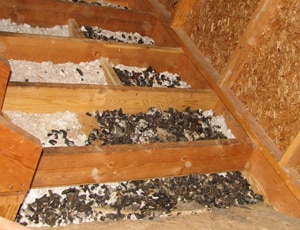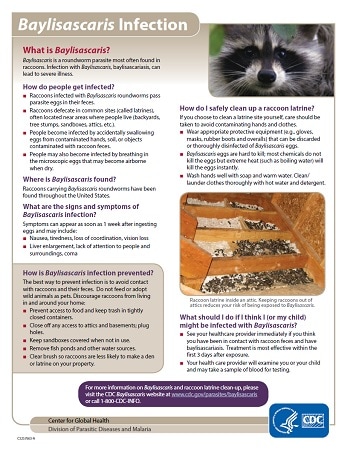Baylisascaris Infection Fact Sheet
What is Baylisascaris?
Baylisascaris is a roundworm parasite most often found in raccoons. Infection with Baylisascaris, baylisascariasis, can lead to severe illness.
How do people get infected?
- Raccoons infected with Baylisascaris roundworms pass parasite eggs in their feces.
- Raccoons defecate in common sites (called latrines), often located near areas where people live (backyards, tree stumps, sandboxes, attics, etc.).
- People become infected by accidentally swallowing eggs from contaminated hands, soil, or objects contaminated with raccoon feces.
- People may also become infected by breathing in the microscopic eggs that may become airborne when dry.
Where is Baylisascaris found?
Raccoons carrying Baylisascaris roundworms have been found throughout the United States.
What are the signs and symptoms of Baylisascaris infection?
Symptoms can appear as soon as 1 week after ingesting eggs and may include:
- Nausea, tiredness, loss of coordination, vision loss
- Liver enlargement, lack of attention to people and surroundings, coma

How is Baylisascaris infection prevented?
The best way to prevent infection is to avoid contact with raccoons and their feces. Do not feed or adopt wild animals as pets. Discourage raccoons from living in and around your home:
- Prevent access to food and keep trash in tightly closed containers.
- Close off any access to attics and basements; plug holes.
- Keep sandboxes covered when not in use.
- Remove fish ponds and other water sources.
- Clear brush so raccoons are less likely to make a den or latrine on your property.
How do I safely clean up a raccoon latrine?
If you choose to clean a latrine site yourself, care should betaken to avoid contaminating hands and clothes.
- Wear appropriate protective equipment (e.g., gloves, masks, rubber boots and overalls) that can be discarded or thoroughly disinfected of Baylisascaris eggs.
- Baylisascaris eggs are hard to kill; most chemicals do not kill the eggs but extreme heat (such as boiling water) will kill the eggs instantly.
- Wash hands well with soap and warm water. Clean/launder clothes thoroughly with hot water and detergent.

Raccoon latrine inside an attic. Keeping raccoons out of attics reduces your risk of being exposed to Baylisascaris.
What should I do if I think I (or my child) might be infected with Baylisascaris?
- See your healthcare provider immediately if you think you have been in contact with raccoon feces and have baylisascariasis. Treatment is most effective within the first 3 days after exposure.
- Your health care provider will examine you or your child and may take a sample of blood for testing.
For more information on Baylisascaris and raccoon latrine clean-up, please visit the CDC Baylisascaris website at www.cdc.gov/parasites/baylisascaris or call 1-800-CDC-INFO.
